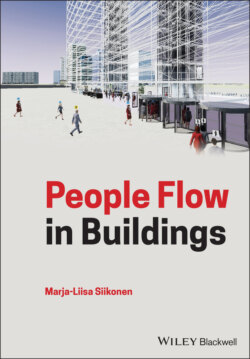Читать книгу People Flow in Buildings - Marja-Liisa Siikonen - Страница 2
Table of Contents
Оглавление1 Cover
4 Preface
7 Part I: Measured People Flow in Buildings 1 Building Design Population 1.1 Office Building Population 1.2 Number of Inhabitants in Residential Buildings 1.3 Number of Hotel Guests 1.4 People Arriving from Parking Areas 1.5 Population in Hospitals 1.6 Other Types of Populated Buildings 2 People Counting Methods 2.1 Counting Technology Inside and Outside Buildings 2.2 Passenger Traffic Components 2.3 Manual People‐counting 2.4 Use of Optical Vision 2.5 Visitor‐counting with Photocell Signals and Infra‐red Beams 2.6 People‐counting with Access Control System 2.7 Passenger‐counting by Load‐weighing Device 2.8 Elevator Monitoring Systems 2.9 External Traffic Measurement Devices 2.10 Smart Sensing and Mobile Computing 3 Passenger Arrival Process in Buildings 3.1 Introduction 3.2 Poisson Arrival Process 3.3 Passenger Arrivals in Batches 4 Daily Vertical Passenger Traffic Profiles 4.1 Introduction 4.2 Vertical Building Traffic Components 4.3 Two‐Way Traffic and Effect of Measurement Interval 4.4 Effect of Inter‐Floor Traffic 4.5 Occupancy in Buildings 4.6 Passenger Trips with Elevators 4.7 People Flow in Office Buildings 4.8 People Flow in Hotels 4.9 People Flow in Residential Buildings 4.10 People Flow Profiles in Hospitals 4.11 People Flow in Commercial and Public Buildings 4.12 People Flow on Cruise Ships 5 Monitored Elevator Traffic Data 5.1 Introduction 5.2 Service Quality Parameters 5.3 Measured Passenger Service Level 5.4 Measured Elevator Performance
8 Part II: People Flow Solutions 6 Historical Overview 7 Push‐Button Control Systems 7.1 Signal Operation 7.2 Single‐Button Collective Control 7.3 Down Collective Control 7.4 Interconnected Full Collective Control Principle 8 Collective Group Control System 8.1 Software‐Based Collective Control System 8.2 Bunching 8.3 Next Car Up 8.4 Dynamic Sub‐zoning 8.5 Channelling 8.6 Queue Selective Control System 9 Intelligent Group Control Systems 9.1 Performance Requirements 9.2 Control System Architectures 10 Artificial Intelligence in Elevator Dispatching 10.1 Introduction 10.2 AI Architectures 10.3 Traffic Forecasting 10.4 Fuzzy Logic 10.5 Genetic Algorithm 10.6 Neural Networks 10.7 Optimization Objective Functions 10.8 Elevator Lobby with Collective Control System 10.9 Hospital Service Modes 11 Destination Control System 11.1 Adaptive Call Allocation Algorithm 11.2 Destination Control System 11.3 Hybrid Destination Control System 11.4 ‘Harmonized’ Elevator Dispatching 11.5 Elevator Lobby with Destination Control System 12 Multi‐Car Control Systems 12.1 Introduction 12.2 Paternoster 12.3 Odyssey 12.4 Double‐Deck Elevators 12.5 TWIN 12.6 MULTI 12.7 Other Possible Multi‐Car Elevator Control Systems 13 Access Control Systems 13.1 Application Areas 13.2 Access Control by an External Provider 13.3 Access Control Embedded in an Elevator Control 14 Architectural Considerations of Elevators 14.1 Layouts with Conventional Control 14.2 Layouts with Destination Control System 14.3 Dimensions of Passenger Elevators 14.4 Vertical Elevator Dimensions 14.5 Lobby Arrangement with Double‐Deck Elevators 15 Architectural Considerations of Other People Flow Solutions 15.1 Escalator Arrangements 15.2 Horizontal Escalator Dimensions 15.3 Vertical Escalator Dimensions 15.4 Dimensions of Moving Walkways 15.5 Staircase Dimensions 15.6 Building Door Types
9 Part III: People Flow Calculation Methods 16 Introduction 17 Elevator Traffic Calculation Methods 17.1 Elevator Performance Parameters 17.2 Elevator Handling Capacity Equation 17.3 Elevator Kinematics 17.4 Up‐Peak Round Trip Time Equations 17.5 Round Trip Time‐Related Equations 17.6 Multi‐Car Traffic Analysis 17.7 Egress Time with Elevators 18 Passenger Service Level 18.1 Queuing Theoretical Approach 18.2 Queuing at Hot Spots 19 Pedestrian Traffic 19.1 People Flow Density 19.2 Escalator Handling Capacity 19.3 Handling Capacity of Moving Walkways 19.4 People Flow in Walkways 19.5 People Flow in Staircases 19.6 People Flow in Corridors and Doorways 19.7 Handling Capacities of Turnstiles and Ticket Counters 19.8 Number of Destination Operation Panels
10 Part IV: People Flow Simulation Methods 20 Introduction 21 Traffic Simulation Methods 21.1 Monte Carlo Simulation 21.2 Passenger Traffic Generation 21.3 Traffic Simulation of an Elevator Group 21.4 Building Traffic Simulation 21.5 People Flow Simulation 22 Simulation Procedure 22.1 Simulated Handling Capacity 22.2 Initial Transient 22.3 Stepwise or Ramp Arrival Profiles 22.4 Traffic Patterns 23 Validation of Elevator Traffic Simulation Software 23.1 Introduction 23.2 Verification of Simulator Models 23.3 Validation of the Elevator Traffic Simulator 24 Simulated Elevator Performance and Passenger Service Level 24.1 Introduction 24.2 Up‐Peak Boosting 24.3 Traffic Simulations with Diverse Control Systems 24.4 Comparison Handling Capacities 24.5 Service Time Distributions with Conventional System
11 Part V: People Flow Planning and Evacuation 25 Introduction 26 ISO 8100‐32 26.1 Background 26.2 Design Process 26.3 ISO Calculation Method 26.4 ISO Simulation Method 26.5 Selection of Rated Load Based on Mass 26.6 Selection of Rated Load Based on Area and Mass 27 Design Criteria 27.1 ISO 8100‐32 Design Criteria 27.2 BCO Design Criteria for Offices 27.3 Other Design Criteria 28 Elevatoring Low‐ and Mid‐Rise Buildings 28.1 Offices 28.2 Hotels 28.3 Residential Buildings 28.4 Hospitals 28.5 Parking Areas 29 People Transportation in Commercial and Public Buildings 29.1 Mass Transits 29.2 Public Transportation Buildings 29.3 Commercial Buildings 29.4 Observation Decks 30 Elevatoring Tall Buildings 30.1 Background 30.2 Zoning of Super Tall Buildings 30.3 Example Zonings of a Super Tall Building 30.4 Zoning from the Ground 30.5 Sky Lobby Arrangement 30.6 Core Space of Different Arrangements 31 Building Evacuation 31.1 Introduction 31.2 Egress Time Calculation in Building Design 31.3 Generic Emergency Evacuation Types 31.4 Total Evacuation 31.5 Staged Evacuation 31.6 Fractional Evacuation 31.7 Elevator Evacuation‐related Standards and Guidelines 31.8 Evacuation Strategies of Megatall Buildings 32 How High Can We Go?
12 Epilogue
13 Glossary
14 Appendix
15 Bibliography
16 Index
